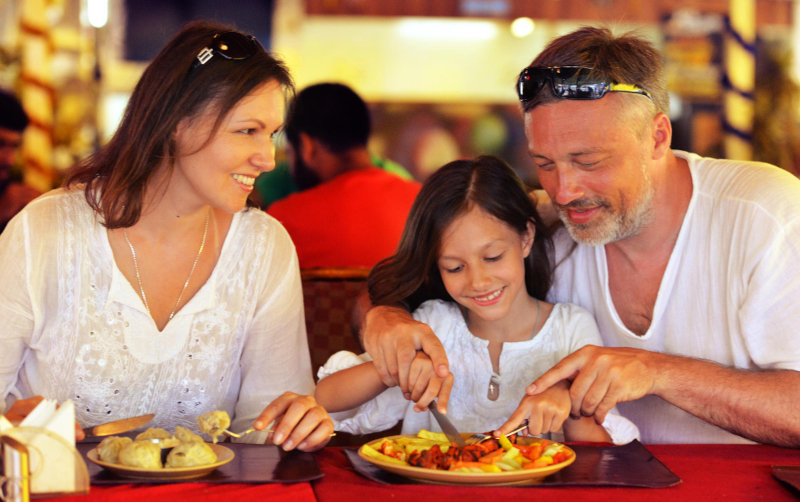Summer is the perfect time for a family road trip, creating unforgettable memories and bonding experiences. However, as a busy parent, it can be challenging to maintain a healthy lifestyle while traveling with kids. Between fast food stops and long hours spent in the car, it’s easy to neglect healthy eating habits and exercise routines. But fear not! Let’s talk about practical tips on how to eat healthy on the road, incorporate exercise into your journey, and set a positive example for your children. Let’s embark on a healthy and enjoyable family road trip this summer!
Plan Ahead for Healthy Eating on Your Family Road Trip
You already probably planned the route, destination, and lodging of your road trip. Why stop there? One of the biggest challenges during a road trip is finding nutritious food options that are both satisfying and healthy. Oh and it helps if the kids eat it too. Here are some tips to help make that happen:
Pack Healthy Snacks: Stock up on wholesome snacks like fresh fruit, cut vegetables, trail mix, whole-grain crackers, and yogurt cups. These portable snacks will keep hunger at bay without relying on unhealthy alternatives.

Bring a Cooler: A cooler is an invaluable asset during a road trip. It allows you to store perishable items such as pre-made sandwiches, salads, and cold beverages, keeping them fresh and accessible.
Research Local Restaurants: Before you hit the road, research the places you’ll be passing through or staying at. Look for restaurants that offer healthier menu options, including salads, grilled items, and vegetarian choices. This way, you can make informed decisions when dining out. If you use something like Google Maps, you can search for places to eat and add stops on your route. Many other map or direction apps have this feature as well.
Stay Hydrated: Drinking enough water is crucial for maintaining good health while traveling. Bring refillable water bottles for everyone in the family, and make it a habit to hydrate regularly. Limit sugary drinks and opt for water, herbal tea, or unsweetened beverages.
Make Exercise a Priority
Sitting in a car for prolonged periods can take a toll on your physical well-being. Incorporating exercise into your road trip not only helps you stay fit but also provides an opportunity for the entire family to burn off some energy.
Plan Active Rest Stops: During long drives, schedule regular stops at rest areas or parks where you can engage in physical activities. Take short walks, play catch, or have a mini picnic with healthier snacks. These breaks will refresh both the body and mind.
Embrace Outdoor Activities: Choose destinations that offer outdoor activities like hiking, biking, or swimming. Research family-friendly trails or parks along your route and include them in your itinerary. These activities provide a great way to exercise while exploring new places. Again, Google Maps or a similar app will help you plan as you travel.
Involve the Kids: Encourage your children to participate in physical activities along the way. Play active games, organize scavenger hunts, or have dance-offs inside or outside the car. By involving them, you foster their love for movement and inspire them to lead an active lifestyle. It’s also a great way to get them to unplug for a while from their phones, tablets and other electronics.

Incorporate Simple Bodyweight Exercises: Even without access to a gym or exercise equipment, you can still perform effective bodyweight exercises. These exercises require no special equipment and can be done anywhere.
Portable Family Road Trip Exercises
Squats
Squats are a fundamental lower body exercise that targets multiple muscle groups, including the quadriceps, hamstrings, and glutes. To perform a squat, stand with your feet shoulder-width apart, lower your body by bending your knees, and then push back up to the starting position. Squats help improve lower body strength, stability, and mobility. By including squats in your exercise routine, you can enhance your overall leg and core strength, which is beneficial for activities like walking, hiking, and maintaining good posture.
Lunges
Lunges are excellent for strengthening the lower body, particularly the quadriceps, hamstrings, glutes, and calves. To perform a lunge, take a step forward with your right foot, lowering your body until both knees are bent at a 90-degree angle. Push back up to the starting position and repeat with the other leg. Alternating between legs, lunges help improve balance, stability, and muscular endurance. They are particularly beneficial for activities that involve single-leg movements, such as climbing stairs or hiking uneven terrain.
Push Ups
Push-ups are a classic bodyweight exercise that targets the muscles of the upper body, including the chest, shoulders, triceps, and core. To perform a push-up, place your hands shoulder-width apart on the ground, extend your legs behind you, and lower your chest to the ground by bending your arms. Push back up to the starting position. Push-ups help build upper body strength, enhance muscle definition, and improve core stability. They are valuable for maintaining strong chest and arm muscles, which contribute to better posture and overall upper body function.
Planks
Planks are a highly effective exercise for strengthening the core muscles, including the abdominals, obliques, and lower back. To perform a plank, assume a push-up position but rest your forearms on the ground. Hold this position, keeping your body in a straight line and engaging your core muscles. Planks help develop core stability, improve posture, and enhance overall body strength. By practicing planks regularly, you can improve your ability to stabilize your spine, which is essential for activities that involve bending, lifting, and twisting motions.
Jumping Jacks
Jumping jacks are a dynamic exercise that engages the entire body, elevates the heart rate, and promotes cardiovascular fitness. To perform jumping jacks, start with your feet together and arms at your sides. Jump, spreading your feet wide and raising your arms overhead. Jump back to the starting position, and repeat for a set number of repetitions. Jumping jacks help improve cardiovascular endurance, coordination, and muscular endurance. They provide a fun and energizing way to warm up the body and increase blood circulation, making them an ideal exercise during rest stops or as a quick burst of activity.
Incorporating these bodyweight exercises into your road trip fitness routine will help you maintain and improve your strength, endurance, and mobility. They require no special equipment and can be performed in a small space, making them perfect for staying active while on the go. Remember to start with proper form and gradually increase the number of repetitions or the duration of each exercise as your fitness level improves.
Setting a Healthy Example on Your Family Road Trip
As a busy parent, your actions speak louder than words. Your kids take cues from you no matter how old they are (or what they tell you). By practicing simple healthy habits yourself, you set a positive example for your children. Here are some ways to lead by example.
Choose Healthy Options: When dining out or buying snacks, make healthier choices for yourself. Opt for salads, grilled proteins, or vegetable-based dishes. Your children will notice and learn to make better choices themselves.
Prioritize Physical Activity: Demonstrate the importance of exercise by incorporating physical activity into your daily routine. Go for walks or bike rides together as a family, explore nature, or engage in active playtime at parks.
Involve the Kids in Meal Planning: Let your children help plan meals and snacks for the road trip. Discuss the importance of balanced nutrition and encourage them to make healthier choices. This involvement will foster their interest in nutritious foods.
Practice Mindful Eating: Avoid mindless snacking and encourage your family to eat mindfully. Sit down together during meal times, focus on the flavors and textures of the food, and engage in meaningful conversations. This practice promotes healthy eating habits and helps control portion sizes.
Should I lower my calorie intake if I will be in the car for a prolonged time?
When embarking on a family road trip and spending prolonged hours in the car, it’s important to strike a balance with your calorie intake. While it may be tempting to reduce your calorie intake due to limited physical activity, it’s equally important to nourish your body adequately for the journey. Here’s some tips we like to help you strike that balance.
Choose Nutrient-Dense Foods: Focus on consuming foods that are nutrient-dense, meaning they provide a high amount of essential nutrients relative to their calorie content. Opt for whole grains, lean proteins, fruits, vegetables, and healthy fats. These foods will provide sustained energy and essential nutrients to support your body’s needs during the road trip.
Control Portion Sizes: Pay attention to portion sizes, especially when snacking on calorie-dense foods like chips, candies, or sugary beverages. Portion out individual servings to avoid mindless eating. Consider using smaller containers or resealable bags to manage portion sizes effectively.
Stay Hydrated: Hydration is important, even during long car rides. Drinking enough water helps maintain overall health and keeps you alert and focused. It’s easy to mistake thirst for hunger, so be sure to stay hydrated throughout the trip. Bring refillable water bottles for the entire family and make it a habit to drink water regularly.
Listen to Your Body’s Hunger Cues: Pay attention to your body’s hunger and fullness signals. Eat when you’re hungry and stop when you feel satisfied. Mindful eating can help prevent overeating and unnecessary calorie consumption. Be mindful of emotional eating triggers and focus on fueling your body rather than turning to food for comfort or boredom.
Plan Balanced Meals and Snacks: Take the opportunity to plan balanced meals and snacks ahead of time. Include a combination of protein, carbohydrates, and healthy fats in your meals to keep you satiated and energized. For example, pack a sandwich with whole-grain bread, lean protein (such as turkey or chicken), and plenty of veggies. Pair it with a side of cut fruits or raw vegetables and a small serving of nuts or trail mix for healthy fats.
Be Mindful of Roadside Dining Options: When stopping at restaurants or fast-food establishments, make informed choices. Look for healthier options on the menu, such as salads, grilled proteins, or vegetable-based dishes. Opt for lighter dressings and ask for modifications to reduce calorie and fat intake. Consider sharing larger meals or selecting smaller portion sizes to manage calorie intake.

Remember, it’s important to fuel your body with the necessary nutrients for optimal functioning, especially during a road trip where you and your family will be active and engaged. While it’s essential to be mindful of portion sizes and make informed food choices, drastically reducing your calorie intake may leave you feeling fatigued and lacking the energy needed for an enjoyable trip. Focus on balance, nutrient-dense choices, and listening to your body’s cues to maintain a healthy eating routine during your family road trip.
Closing Thoughts
A family road trip doesn’t have to derail your healthy lifestyle. With some planning and conscious choices, you can maintain nutritious eating habits, incorporate exercise into your journey, and set a positive example for your children. By prioritizing healthy options, engaging in physical activities, and involving your kids in the process, you can make this road trip a memorable and health-conscious experience for the whole family. So, buckle up, hit the road, and enjoy a summer adventure while staying on track with your well-being goals!

